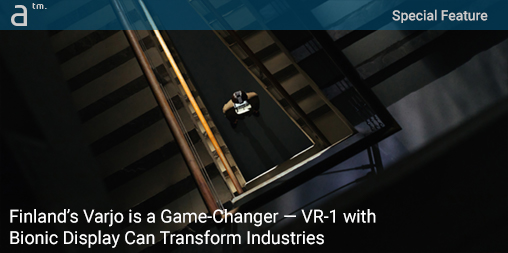Continued from page 2
Game Changing Advantages
Varjo VR-1 can offer a radically cheaper alternative to pilot simulation and training. Honed by their interactive work with beta partner Saab AB, which was using the technology for their Grippen fighter program, Kontorri told me that the VR-1 was seen as a game-changer.
“So we have been told by many of the aircraft makers that what we are offering is a complete revolution in the training industry,” he said. At the moment, the million dollar dome-based simulation and training systems are in short supply. Furthermore, pilots need to travel far—typically to the aircraft manufacturers’ facilities—to train on the simulators. With the Varjo VR-1, alternative simulation and training can be placed at the facilities of the airline operators.

Varjo VR-1’s accuracy and visual clarity mean that pilots can train is far less costly training setups using VR-1 than in multi-million dollar full dome simulators.
When it comes to Varjo’s three main market areas (AEC, Design, and Simulation and Training), it is simulation and training that is driving the most significant revenues thus far. “The full dome simulators cost a couple grand per hour,” said Konttori. “If you can replace that system with something that costs once just ten grand or even twenty, it becomes a no-brainer, and you actually want to go there. So the business case is instant.”
He adds that on the design side for the automakers or the large enterprises you have the same business logic. “If you can shave off even just weeks on the design of a new car, something that typically takes years, it can mean huge savings and beating your rivals to market.”

Audi and other car makers have told Varjo that the VR-1 can save weeks and months off the development time for a new vehicle model, enabling faster time to market over competitors and dramatic savings in car development time.
For the Architecture industry, it is the enterprise-sized firms that are telling the Finnish company the business case is strong. With the Varjo VR-1 architecture firms are cutting down on the number of physical models and it is also speeding up the design process itself. Konttori said that for smaller firms he does see the whole AEC segment eventually coming around to VR. “It’s going to happen fast once the ball starts actually rolling.”
Varjo VR-1 Basics
Getting going with the VR-1 is also getting easier. Aside from the company’s API for software developers, there are Unity and Unreal plugins that make pushing your model to the headset a simple process for those using game-engine workflows. Varjo is also committed to the Khronos Group’s OpenXR open-industry standard, which will make it easier for all VR software makers to work with a variety of actual VR hardware.
Most of Varjo’s customers already own either an Oculus Rift or HTC Vive. The VR-1 works with Steam VR technology. “We decided we wanted to use best-in-class tracking technology and chose Steam VR technology,” said Konttori. The VR-1 pairs up with Vive controllers and lighthouses, so a customer’s Vive setup is ready to go for a new Varjo VR-1.
Looking Down the Road with Varjo
The future of VR is quite healthy from where this Finnish company is standing. While the device carries a $5,999.USD price tag and is only available to businesses and institutions the flagship headset is shipping worldwide, and the company is growing. With fundraising over $46 million and a new US-based office on the east coast near Washington DC—a location that may suggest business connections with government agencies like the Pentagon—Varjo has little reason to worry about VR falling out of favor due to AR (augmented reality) emerging on the scene.

The Varjo VR-1 is proving a game-changer in multiple industries and their design and engineering workflows. The device is VR today but soon to set to be supplemented by a mixed reality (MR) adaptor kit giving it even more value to companies.
In fact, the company plans to release its mixed reality (MR) technology very soon. The MR product will be an add-on to the VR-1, not an entirely new device. In fact, the next-generation Varjo won’t likely come until around early 2020, says Konttori, who made no promises or commitments with schedules but only said that Oculus and Vive ship new units around every 24 months.
Mixed Reality may be Varjo’s next act, but Konttori notes that “human-eye” resolution-based virtual reality (VR) solves issues that AR and MR simply don’t. “We see MR as a huge thing but it’s really interesting to think of a car designer because they couldn’t care less about how their car looks at their office. What they want is to see their car on a specific road or Berlin Plaza. Again, it’s the VR technologies we have in Varjo VR-1 that brings these capabilities to the market,” said Konttori.





Reader Comments
Comments for this story are closed